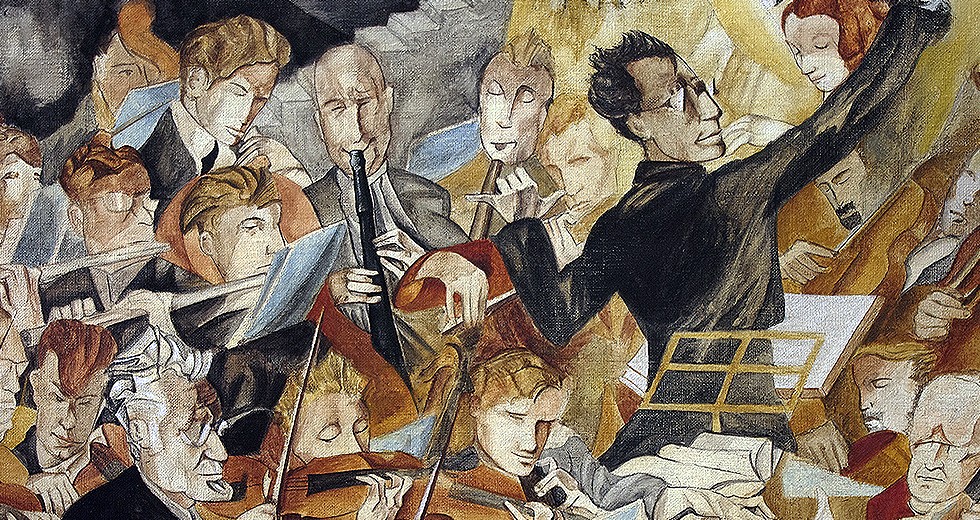
It’s difficult, if not impossible, to hold a fixed perspective on a work of art. We grow, we age, our situations change, our tastes become more (or less) refined. Thirty years ago, when I read King Lear in college, it was a story about an unreasonable parent. Now when I read it, it’s a story about ungrateful children.
Meanwhile, it can be unusually difficult for an artist to communicate to an audience that is not ready to hear what he is saying. Case in point, Gustav Mahler’s Symphony No. 1 in D Major, which for many reasons began life as a Symphonic Poem in two parts, then became The Titan – Tone poem in the form of a symphony, then Symphony No. 1 in D Major (Titan) before arriving at its current simple appellation. It seems to be the story of someone saying “OK, let me explain it to you this way,” over and over until everyone understands. Even then, classical music faced marketing problems.
The Chicago Symphony Orchestra, under Riccardo Muti, performs Mahler’s First Symphony in concerts June 19-21.
In 1884, Mahler had endured the collapse of his love affair with the soprano Johanna Richter and had consoled himself by writing poetry. Amid the emotional turmoil of lovesickness, he set some of these texts to music — his Songs of a Wayfarer — while planning his first voyage into the symphonic form.
Songs of a Wayfarer tells the story of someone who loses his beloved to someone else. By the end of the cycle, the heartbroken central character has finally found peace in death. Musical themes from this song cycle found their way into the new work, at this time called a Symphonic Poem in two parts.
In retrospect, it is easy to see the work’s autobiographical and deeply personal nature, but at its premiere in Budapest in 1889, its first listeners were baffled and annoyed. The extreme changes in mood seemed bewildering and Mahler had declined to provide any guidance. It was a “poem,” and clearly about something, but what? The piece was greeted with boos and scattered applause.
After the work’s initial failure, Mahler began revisions; not just musically, but conceptually. Four years after the debut, on Oct. 27, 1893, Mahler conducted the revised work in Hamburg, having now titled it The Titan — Tone poem in the form of a symphony. He took Titan from a novel by German author Jean Paul (also the story of a romantic dreamer with a broken heart), and if that wasn’t enough, Mahler provided programmatic descriptions for each movement, which progress from the sunny, youthful “Never ending spring” and the forward-looking optimism of “The sails are fully set” to “Shipwrecked (a funeral march)” and end with “Dall’ Inferno al Paradiso, the sudden burst of desperation of a deeply wounded heart.”
No one could say they weren’t prepared.
This time the work was met with applause and positive reviews; by the late 1890s, following some further revision — the removal of an entire movement, “Blumine,” which wasn’t rediscovered until 1966(!), and the removal of all program notes and the Titan title — we had the symphony in its final form and final name, the Symphony No. 1 in D Major.
After all that, Mahler had come to a point where he resented the idea that the work could be interpreted too literally. Despite its gestation out of his own heartache, he began referring to the work ironically as “the so-called Titan.” And for programmatic music in general? “There exists no modern music which hasn’t its inner program,” he wrote to a friend. “But no music is worth anything when the listener must be instructed as to what is to be experienced in it.”
The voyage, then, is instructive. He couldn’t deny that his “whole life is contained in [the first two symphonies]; I have set down in them all my experience.” But as deeply personal as the first symphony is, his artistic ambitions transcended the personal. The musical story of the first symphony is not a “plot” that happens to a “character” (whether Mahler or The Titan). It is the musical articulation of an emotional state, accessible to anyone. It is an individual’s story that expresses a community’s common pain. It is both personal and public, specific and generalized, depicting a shared inner world of brokenness, grief, and ultimately (one hopes) triumph and rest.
Peter Lefevre, based in California, writes about music for the Orange County Register and Opera News.
ABOVE: A detail from Max Oppenheimer’s Das Orchester: Gustav Mahler dirigiert die Wiener Philharmoniker.